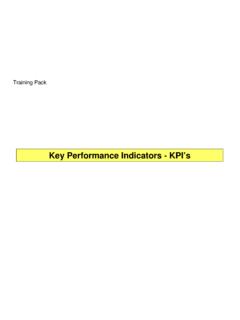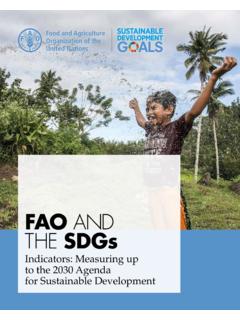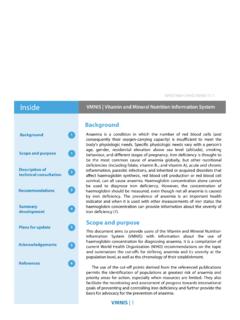Transcription of Key Performance Indicators in Humanitarian …
1 Key Performance Indicators in Humanitarian logistics by Anne Leslie Davidson Submitted to the Engineering Systems Division on May 19, 2006, in Partial Fulfillment of the Requirements for the Degree of Master of Engineering in logistics Executive Summary When disasters strike, relief organizations respond by delivering aid to those in need. Their supply chains must be both fast and agile, responding to sudden-onset disasters which may occur in cities such as New Orleans, or on the other side of the globe in places like rural Pakistan. Since 2004, two large-scale natural disasters have captured the attention of the international media: the 2004 tsunami and the 2005 earthquake in South Asia. Disasters of this magnitude cause donors, beneficiaries, and the media to closely monitor how quickly and efficiently relief organizations are able to respond.
2 A disaster response operation involves trade-offs of speed, cost, and accuracy with regard to the type of goods that are delivered and their quantities. Balancing these trade-offs requires a means of measuring supply chain Performance ; however, the inability to centrally capture time and cost data related to the procurement and distribution of goods has prevented a systematic process of Performance measurement from being implemented. Today in the logistics department of the International Federation of Red Cross and Red Crescent Societies (IFRC), software that was co-developed with the Fritz Institute makes it possible to capture the necessary data which will inform the IFRC of their supply chain's Performance .
3 Page 1 of 11. This executive summary begins by examining the underlying principles of logistic Performance measurement systems from the military and commercial sectors and applying them to disaster relief operations. These principles were used to develop four Indicators which measure logistic Performance in terms of the trade-offs of speed, cost and accuracy: appeal coverage, donation-to-delivery time, financial efficiency, and assessment accuracy. Taken together, these Indicators create a scorecard that will help the logistics department gauge Performance both during and after a relief operation. To show how this system would be used by a relief organization, scorecards have been re-created for the 2005 South Asia earthquake operation of the IFRC.
4 The executive summary concludes by describing one of the key issues which may arise when a Performance measurement system is implemented, which is how to manage the cultural change that is needed in organizations unaccustomed to Performance measurement. Although this research was performed with an international non-profit Humanitarian organization in mind, the principles of measurement that are described are relevant to other organizations which participate in disaster relief operations, such as government agencies or national non-governmental organizations. Principles of Performance Measurement from the Commercial and Military Sectors Supply chain professionals in the commercial sector face many of the same issues of trade-offs in Performance as a professional working in a disaster relief operation.
5 In business and in disaster relief supply chains, speed is of the essence. Even more striking in parallel are military supply chains, which often face similarly short deployment periods and challenging working environments. Because of these similarities, it is important to understand the underlying principles of commercial and military Performance measurement systems when Page 2 of 11. developing a system for disaster relief operations. The following three principles emerged from business research journals and from research studies of the Army as the most applicable to the Humanitarian sector. Align metrics to the organization's core strategy (Lambert, 2001). If a metric is not critical to fulfilling an organization's core strategy, it should not be included on the scorecard.
6 There is a tendency when designing Performance measurement systems that more is better, but if too many metrics are selected, the scorecard can become too cluttered, preventing individuals from truly gauging Performance . Understand the dynamics of how Performance is driven (Caplice & Sheffi, 1994). The faster that goods are delivered to beneficiaries after a disaster, the less likely these goods are accurately meeting the needs of the beneficiaries, and the more likely the operation will be costly. The organization responding must decide in advance how it wants to align itself along the dimensions of speed, accuracy, and cost. Review the metrics periodically as Performance improves (Meyer, 2005). The goal of implementing metrics is to improve Performance over time, and as goals are achieved, targets must be re-evaluated and revised as necessary to ensure continuous improvement in the organization's supply chain.
7 Framework of Four Performance Indicators To develop our framework of four Performance Indicators , we first conducted interviews with the professionals at the IFRC in order to understand their supply chain and their organization's strategic goals. We then examined the data for the 2005 South Asia earthquake operation that was captured in Humanitarian logistics Software (HLS). This software was implemented by the IFRC in 2003, to track information relating to the Page 3 of 11. procurement and distribution of goods for all major emergency operations. Using the organization's goals of how they strive to deliver goods to beneficiaries and using the data available from HLS, we developed the set of four Indicators : appeal coverage, donation-to- delivery time, financial efficiency, and assessment accuracy.
8 These Indicators do not represent pure index calculations, but rather they serve to help the logisticians get a sense of how well they are achieving their goals related to each appeal, the term which refers to the list of items recorded on an operation's total budget. 1. Appeal Coverage: This indicator is comprised of two specific metrics: 1) percent of appeal coverage and 2) percent of items delivered. The first metric is the quantity of items that have been pledged by donors out of the total number of items requested for the operation. Its purpose is to indicate how well and how quickly the organization is finding pledges for the requested items. The second metric is the percentage of items that have actually been delivered on-site out of the total number of items requested for the operation.
9 Together, these two metrics indicate how well the organization is meeting its appeal for an operation in terms of both finding donors and delivering items. 2. Donation-to-Delivery Time: This indicator is a measure of how long it takes for an item to be delivered to the destination country after a donor has pledged to donate it. Both the mean and median number of days are reported on the scorecard, which is a practice used in the Army's Performance measurement system (Dumond, 2000). These two metrics help gauge both the average and the consistency of the delivery lead times. 3. Financial Efficiency: Three metrics comprise the indicator of financial efficiency. The first two metrics use two methods (one relative and one absolute) to compare the budgeted prices to the actual prices paid for items delivered in the operation.
10 The third financial Page 4 of 11. efficiency metric incorporates the transportation cost of delivering the goods to the beneficiaries. This metric is expressed as a ratio of the total transportation costs incurred over the total costs for delivered items at a point in time. The value of this ratio should decrease over time, as less expensive transport methods are used after the initial delivery phase and as more items are delivered on-site. 4. Assessment Accuracy: How quickly donations are pledged and goods are delivered to beneficiaries relies on how accurately the field personnel assessed the needs of the population affected after a disaster. Assessment accuracy therefore indicates how much the operation's final budget changed over time from the original budget.











